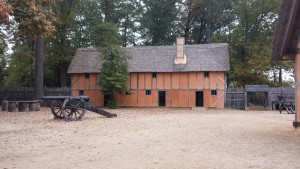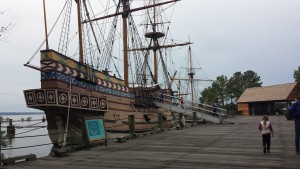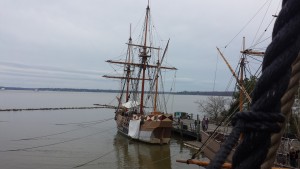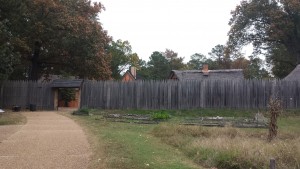“History is fun” is the domain name of the Jamestown Settlement and Yorktown Victory Center website. History is fun and alive at Jamestown Settlement, a living recreation of early Seventeenth Century Virginia. Considered the first permanent English settlement in the U.S., Jamestown Settlement depicts life as it might have been in 1607 for Powhatan Indians and their new English neighbors.
Enter the museum campus and one finds relics and stories along a timeline corridor about the who, what and when of the early settlers, Native and enslaved peoples in that region and more. However, the real action takes place outside of the museum, where one can interact with interpreters at the Powhatan Village and English fort. There are also three replicas of the ships Susan Constant, Godspeed and Discovery accessible for viewing.
At the Powhatan Village, we investigated the homes — yehakins — and tried to figure out which one belonged to the chief, which was outfitted with headdress and extra room. Each handcrafted, weaved home included a fire ring, baskets with up to twenty-one arrows or those meant for gathering, animals hides, beds and a plethora of decorations. They were large, sturdy and intricate and smelled heavily of smoke from burning all-day fires. There were areas for learning how to remove hair from deer hide, for practicing archery, to practice weaving and to make tools, such as fishing hooks carved from deer bones. The Powhatan had no written language, and many of their traditions were lost because of it, especially after the English introduced metal. The ancient ways of creating a weaving tool were trumped by an iron needle that rarely dulled and was sharper than anything created from an animal.
Luna took to digging a canoe. A recent char of the giant tree trunk enabled her some time to scrape (and scrape and scrape) with her oyster shell. It was incredibly difficult and time consuming, and it gave all of us a sense of how much work went into such a huge endeavor as making a boat, because we barely made a dent. But it was fun and really interesting, and we learned more about what we already knew about our daughter: She really likes detailed work.
Next we found the boats. At first Luna thought it was really fun to climb aboard and all around, but then the anchored Susan Constant bobbed up and down from the wake of a passing boat, which made her uneasy. It made us all a little uneasy, especially when considering fifty passengers and sailors crammed together for over four months on three small ships en route to an ambiguous destination. Sleeping quarters were small mats, latrines sat next to canons and everything was probably always wet.
Constant dampness for the English from the ocean voyage was matched by equally as wet, marshy new land full of beautiful trees and swamps, chirping and flying bugs, but it had long been the territory of the Powhatan Confederacy and they knew it well. At Jamestown Settlement, the area is maintained to give guests an idea of how the land probably looked and felt in 1607. Powhatan picked berries and nuts and plants in the region, as well as hunted. However, it is believed that the Powhatan overhunted the deer population: Killing and eating a fresh deer was less work than killing and trying to preserve an animal for later. As a result, their hunting territory — and that of the English — spread north toward Richmond, making hunting trips full-fledged family events.
When the English arrived, the humid marshland was new to them, but modern tools, carpentry and weaponry were not, and that is apparent in the fortified community built near the Powhatan Village. Used to “settling,” expert carpenters’ first order of business was to construct a storehouse, which held everything required for an upstart fort, including and especially food and gun powder. Once the storehouse was constructed, the community could begin to create other important structures for specific purposes, such as a church, a magazine, a governor’s house, a blacksmith facility, an armory, more residences, fences and more. The crafting of metal changed everything quickly and quite easily. With blacksmith came hinges, nails, weapons and tools. Muzzles took longer to load, but went farther and more quickly than an arrow. All of this reminded Luna of building in Minecraft, which prompted her to ask if the blacksmith had iron ore. We paid him a visit. He gave her a lesson in making nails, as well as gifts of iron ore and a new nail. It made her day.
This is all available for look and feel at the replica fort at Jamestown Settlement and creates a paradoxical setting next to the Powhatan Village. Clearly, the Powhatan lived off the land and with the land; the English lived for it. Iron is everywhere — in the doors, the walls, the armor and the guns. However, the fort and its structures are striking and interesting, and we all tried to imagine ourselves in the shoes of all involved. Much of what has been learned about the Powhatan comes from journals from John Smith and other English documents, as well as from other tribes in the region. Most importantly, the archaeological findings at the nearby Historic Jamestowne dig give much needed information to those who portray English and Powhatan peoples for shaping story, tool and craft in this true-to-life setting.
There is so much juxtaposition in places like this — giving and the taking; building and destroying; power and submission; desire and acceptance; old and new; open and closed; what is known and what is not. None of it — for anyone — was easy. It was hard work and complex. Again, we are grateful for the experience. One step and one piece at a time, we are building our learning, experience and awareness through travel. It is better than a book — for all of us — if we step outside and look. Perhaps healing, understanding, gratitude, peace and forgiveness can happen if more of us step out of bounds. History can be fun, difficult and enlightening, if you dare.
- Governor’s House at Jamestown Settlement.
- Removing Deer Hair.
- Headed Aboard the Recreated Susan Constant.
- Recreated Ship Discovery.
- English Fort at Jamestown.
- Church at Jamestown Settlement.








Glad to hear you are enjoying the southeast. If you are thinking of the northern part of Florida, the state Park in Fernandina Beach is a good spot. When we head for the west coast, we spend the nite at Flamingo Lake in Jacksonville.